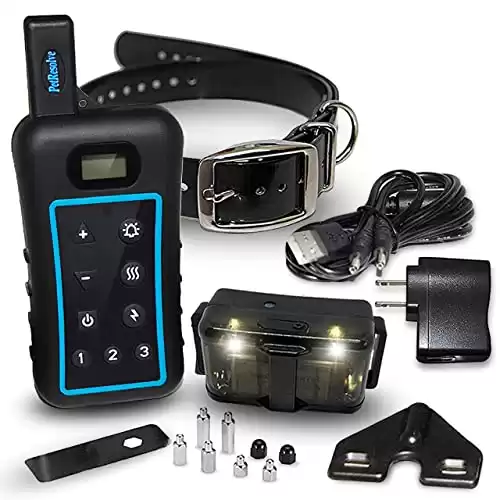Some dogs don’t howl much, and others howl all day long. Some dog breeds are more prone to this howling behavior (we see you, huskies), while others are not. It’s fun when pups howl to sing, but not fun when they wake up the neighbors at 3 am. Dog owners must be OK with a little howling, but excessive howling can be a problem. So, why do dogs howl? And how can you curb unwanted howling?
Why Do Dogs Howl?
Like a lot of puzzling doggie behaviors, we can look back to their undomesticated roots to find the answers. Wolves use howling to communicate with their pack and other animals. They howl to let pack members know where they are and to tell wolves from other packs to stay away. Now that dogs live in families with humans, they still use howling to try to communicate with their “pack.”
What Is Your Dog Trying to Tell You by Howling?
A dog’s howl can mean many different things. Make your best judgment on what your dog is trying to tell you based on the situation.
They Are Alert and Ready
Dogs often howl in response to loud noises, like music or sirens. When they do this, they are showing they are alert and ready to join whatever is happening. With this type of behavior, your dog stops howling once the sound stops. Many people find this type of howling endearing instead of annoying.
They Are Trying to Guide Your Way (Or They Have Separation Anxiety)
If your dog howls when you leave him at home, he may be making sure you know the way back. In the wild, wolves howl to make sure each pack member finds the way home. If your dog howls only when your car pulls into the drive, she is just trying to guide you!
However, a dog howling for hours while left alone at home is often a sign of separation anxiety. This is especially true when paired with other separation anxiety symptoms. These include pacing, going to the bathroom inside, and destructive behaviors. If your dog’s howling is due to separation anxiety, it will stop when you are home. This type of howling can be irritating to neighbors.
Letting a Stranger Know This Is Their Territory
In the wild, wolves howl to deter strange wolves who are not in their pack from entering their territory. Dogs may do this at home too. If a stranger approaches, whether a person or dog, your pup may howl to say “Hey, this is my house!”
Letting You Know They Are on the Way
Wolves sometimes howl when approaching their own pack to avoid startling members. It’s like how you might normally call your friend before you come over so they will not be surprised. If your dog howls when approaching home or fellow household animals, they may simply be saying “It’s just me!”
Telling You They Found Something
Wolves sometimes howl in celebration when they find a good meal after hunting. Your dog may do the same thing. Even though they are not hunters, they may howl if they find something cool in the backyard. They may also display this behavior after going on their own unsanctioned hunting excursion.
They Need Attention
Many dogs are quick learners. If you reinforce howling by giving your pup attention, he will continue to do it every time he wants attention.
They Are Feeling Emotional or In Pain
A howl can be kind of like crying for dogs. If your dog rarely howls and starts doing it suddenly, there may be something going on. They might be in pain, so you should take them to the vet. They may also be feeling emotional over the death of a fellow pet or a family member who has left.
How to Stop Your Dog from Howling
The method you use to stop your dog from howling depends on the cause. Many cases of howling are short-lived occurrences and are just an expected part of doggy behavior. However, too much howling can be a problem.
How to Stop Howling from Attention-Seeking Behavior
If your dog howls because she wants attention, you have to teach her that howling will no longer work. She will only get what she wants by being quiet. You must ignore your dog completely if she howls. Don’t look at her, touch her, or yell. Dogs consider any attention a reward, even if it is negative. You can even turn in the opposite direction, so she learns you will refuse attention during howling.
Then, you must reward quiet behavior. Randomly give your dog a treat once in a while when he is being calm and quiet. If your dog is howling, give him a treat (or whatever he wants) once he is quiet for five seconds.
Another method involves training with commands. You can train your dog to howl when you say “speak” or another command. Then you can train them to stop when you say “quiet” or another similar command. After these tricks are learned, stop giving treats when she obeys the speak command. Only give treats for the quiet command, so she understands that staying quiet is the behavior you like.
How to Stop Howling Due to Separation Anxiety
A training process called counterconditioning can help mild separation anxiety symptoms. This training method helps your dog associate whatever they are afraid of with positive things. These may be a favorite toy, special treats, or an extra yummy meal. With separation anxiety, counterconditioning shows a dog that great things happen when he is at home alone. Give your dog a puzzle toy filled with a tasty treat like peanut butter each time you leave the house. The puzzle toy should take your dog about a half hour to finish. You can freeze it, so it takes even more time. Your dog might actually start to look forward to you leaving the house!
- Includes peanut butter, chicken, and oats
- These crunchy treats contain just 5 calories each
- Free from chicken by-products, artificial flavors, artificial colors, artificial preservatives, corn, wheat, and soy protein
- Made in the U.S.A.
More severe cases of separation anxiety may require a process of desensitization in addition to counterconditioning. Desensitization can be accomplished in just a few weeks with daily or twice-daily training sessions. It involves slowly getting your dog accustomed to being home alone. It starts by training your dog about your pre-departure cues. If your dog freaks out every time you grab your keys, you must first desensitize him to these activities. First, grab your keys. Then, instead of leaving, sit down and read or have a cup of coffee to reduce anxiety about these cues.
The next step is to get your dog used to being separated from you. Train your dog to stay on one side of a door, while you go to the other side and close the door. This is called an out-of-sight stay. Practice doing these for longer and longer. You can also add your pre-departure cues to this. For example, you can put on your jacket and then go into your bedroom and close the door. Once your dog is comfortable with this exercise, practice it at a door that leads outside. However, do not use the door you usually use to come and go. Your coming and going should always be calm and low energy, so as not to contribute to anxiety.
Start with out-of-sight stay exercises that are just a few seconds. Once your dog can go for between five and 10 seconds, start giving her a dog toy or treat right before you go through the door. This will begin the counter conditioning process. You need to increase the time by only a few seconds until you hit 40 minutes. This is because most signs of separation anxiety occur in the first 40 minutes of being alone. Once you hit 40 minutes, you can increase by five and 10-minute intervals. If your dog can be alone for 90 minutes, he may be able to be alone for several hours.
Unfortunately, while you are doing desensitization training, your dog should not be left alone except for during your training sessions. You will need to take your dog to work with you or work from home. You can also arrange for a friend or family member to come and watch your dog.
Other general tips for curbing separation anxiety include:
- Provide your dog with plenty of toys, like a dog ball launcher, while they are home alone.
- Portable - work with batteries
- Suitable for all dogs
- Features a safety alert buzzer
- Use standard size tennis balls
- Give your dog an exciting environment. For example, you can hide small piles of kibble around the house for them to find while you’re gone.
- Provide calming CBD dog treats.
- U.S.A.-grown
- Formulated just for pets
- Contain organic extra-virgin olive oil
- Contain phytocannabinoid-rich hemp
- Give your dog at least a half-hour of exercise each day.
- Take your dog to a training program or obedience school.
- If other options don’t work, talk to your vet about prescription anti-anxiety medicine for your dog.
The photo featured at the top of this post is © Utekhina Anna/Shutterstock.com
Ready to discover the top 10 cutest dog breeds in the entire world?
How about the fastest dogs, the largest dogs and those that are -- quite frankly -- just the kindest dogs on the planet? Each day, AZ Animals sends out lists just like this to our thousands of email subscribers. And the best part? It's FREE. Join today by entering your email below.
FAQs (Frequently Asked Questions)
Why Do Dogs Howl?
Like a lot of puzzling doggie behaviors, we can look back to their roots in the wild, before wolves became domesticated, to find the answers. Wolves use howling to communicate with their pack and other animals. They howl to let other wolves in their pack know where they are and to tell wolves from other packs to stay out of their territory. Now that dogs live in families with humans, they still use howling to try to communicate with their “pack.”
What Is Your Dog Trying to Tell You By Howling?
A dog’s howl can mean many different things. Make your best judgment on what your dog is trying to tell you based on the situation.
They Are Alert and Ready
Dogs often howl in response to loud noises, like music or sirens. When they do this, they are showing they are alert and ready to join whatever is happening. With this type of behavior, your dog stops howling once the sound stops. Many people find this type of howling endearing instead of annoying.
They Are Trying to Guide Your Way (Or They Have Separation Anxiety)
If your dog howls when you leave them at home, they may be trying to make sure you know the way back. In the wild, wolves howl to make sure each member of the pack finds their way back, so everyone can be together again. If your dog howls only when they hear your car pull in or when you come up the steps to your house, they are just trying to guide you.
However, a dog howling for hours while left alone at home is often a sign of separation anxiety, especially when paired with other separation anxiety symptoms like pacing, going to the bathroom inside, destructive behaviors, and more. If your dog’s howling is due to separation anxiety, it will stop when you are home. This type of howling can be irritating to neighbors.
Letting a Stranger (Person or Dog) Know This Is Their Territory
In the wild, wolves howl to deter strange wolves who are not in their pack from entering their territory. Dogs may do this at home too. If a stranger approaches, whether it is a person or another dog, your pup may howl to say “Hey, this is my house!”
Letting You Know They Are On the Way
Wolves sometimes howl when approaching their own pack to avoid startling other members, and to let everyone know they are on their way. It’s like how you might normally call your friend before you come over so they will not be surprised. So, if your dog howls when approaching your house or the other animals of the household, they may simply be saying “I am on the way.”
Telling You They Found Something
Wolves sometimes howl in celebration when they find a good meal after hunting. Your dog may do the same thing. Even though they are not hunters in the same way, they may howl if they find something cool in the backyard or if they went on their own unsanctioned hunting excursion.
They Need Attention
Many dogs are quick learners. If you reinforce howling behavior by giving them attention, they will learn that howling gets them the attention they want and will continue to do it every time they want your attention.
They Are Feeling Emotional or In Pain
A howl can be kind of like crying for dogs. If your dog rarely howls and starts doing it suddenly, there may be something going on. They might be in pain, so you should take them to the vet. They may also be feeling emotional about something like the death of a fellow pet or a family member who has left the household.
How to Stop Your Dog From Howling?
The method you use to stop your dog from howling depends on the cause. Many cases of howling, like howling due to a siren or warning a person, are short-lived occurrences and are just an expected part of doggy behavior. However, too much howling can be a problem.
How to Stop Howling From Attention-Seeking Behavior
If your dog barks because they have learned it will get your attention, you have to teach them that howling is no longer going work, but being quiet will get them what they want. You must ignore your dog completely if they howl. Don’t look at them, don’t touch them, and don’t yell at them. Dogs consider any attention a reward, even if it is negative. You can even turn in the opposite direction from them so they get the idea that you are really not giving them any attention.
Then, you must reward quiet behavior. Randomly give your dog a treat once in a while when it is being calm and quiet. If your dog has been howling, give them a treat (or whatever they are howling for, whether it is pets, a walk, or dinner) once they have been quiet for five seconds straight.
Another method involves training with commands. You can train your dog to howl when you say “speak” or another command. Then you can train them to stop when you say “quiet” or another similar command that you come up with. If you want your dog to stop howling on a regular basis, stop giving them treats when they obey the speak command. Only give them treats for the quiet command, so they begin to understand that staying quiet is the behavior you would like.
How to Stop Howling Due to Separation Anxiety
A training process called counterconditioning can help mild separation anxiety symptoms. This training method helps your dog associate whatever they are afraid of or dislike with positive things, like a favorite toy, special treats, or an extra yummy meal. With separation anxiety, counterconditioning shows a dog that great things happen when they are at home alone. One idea is to give your dog a puzzle toy filled with a tasty treat like peanut butter or wet dog food with kibble each time you leave the house. The puzzle toy should take your dog about a half hour to finish, but you can freeze it so it takes even more time. Your dog might actually start to look forward to when you leave the house!
More severe cases of separation anxiety may require a process of desensitization in addition to counterconditioning. Desensitization can be accomplished in just a few weeks with daily or twice-daily training sessions. It involves slowly getting your dog accustomed to being home alone. It starts by training your dog about your pre-departure cues. If your dog freaks out every time you grab your jacket and keys, you must first desensitize them to these activities. Grab your jacket and keys, and then instead of leaving, sit down and read a book or have a cup of coffee to reduce their anxiety about these cues.
The next step is to get your dog used to being separated from you, even if it is inside the house. Train your dog to stay on one side of a door, while you go on the other side and close the door. This is called an out-of-sight stay. Practice doing these for longer and longer. You can also add your pre-departure cues to this. For example, you can put on your jacket and then go into your bedroom and close the door. Once your dog is comfortable with this exercise, practice it at a door that leads outside, but not the usual door you use to come and go. Your coming and going should always be calm and low energy, so as not to contribute to any reaction your dog may have.
Start with out-of-sight stay exercises that are just a few seconds. Once your dog can go for between five and ten seconds, start giving them a dog toy or treat right before you go through the door to begin the counter conditioning process. You need to increase the time by only a few seconds until you hit 40 minutes. This is because most signs of separation anxiety occur in the first 40 minutes of being alone. Once you hit 40 minutes you can increase by five and 10-minute intervals. By the time your dog can be alone for 90 minutes, they may be able to handle being alone for up to eight hours.
Unfortunately, while you are doing desensitization training, your dog should not be left alone except for during your training sessions. You will need to take your dog to work with you or work from home. You can also arrange for a friend or family member to come and watch your dog, or take them to a doggy daycare.
Other general tips for curbing separation anxiety include:
- Provide your dog with plenty of toys, like a dog ball launcher, while they are home alone.
- Give your dog an exciting environment. For example, you can hide small piles of kibble around the house for them to find while you’re gone.
- Provide calming CBD dog treats.
- Give your dog at least a half hour of exercise each day.
- Take your dog to a training program or obedience school.
- If other options don’t work, talk to your vet about prescription anti-anxiety medicine for your dog.
Thank you for reading! Have some feedback for us? Contact the AZ Animals editorial team.












